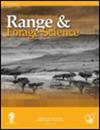The control of the encroaching shrub Seriphium plumosum (L.) Thunb. (Asteraceae) and the response of the grassy layer in a South African semi-arid rangeland
IF 1.9
4区 环境科学与生态学
Q3 ECOLOGY
引用次数: 1
Abstract
Large-scale bush encroachment within rangelands is of increasing concern for land users. The aggressive encroachment of the woody shrub Seriphium plumosum (L.) Thunb. (Asteraceae), previously known as Stoebe plumosa, has resulted in a reduction in productivity, causing large socio-economic challenges, such as loss of productive land. In this study, we evaluated the efficacy of four herbicides in combination with mechanical removal of S. plumosum. We measured shrub mortality, regrowth and examined the grass species richness and cover after the execution of the control methods. Furthermore, we compared the productivity of the paddock where S. plumosum had been controlled with a neighbouring unencroached paddock. Five months after herbicide application, the total mortality of all shrubs was recorded. Grass species richness and cover were higher when shrubs had been mechanically removed before herbicide application. Additionally, the use of the non-speciesspecific herbicide (tebuthiuron) resulted in lower species richness and cover, compared to application of a speciesspecific herbicide (metsulfuron-methyl). The productivity of the treated area increased in the year after application. Our results show that when controlling S. plumosum the manual removal of shrubs before applying herbicides can improve the regeneration of the grass layer. This combination of mechanical and chemical control is effective in combating S. plumosum encroachment and increases forage yields in semi-arid rangelands.沙棘(seripium plumosum, L.)的入侵防治研究。(菊科)与南非半干旱草地草层的响应
草地内大规模的灌木入侵是土地使用者日益关注的问题。木本灌木Seriphium plumosum (L.)的侵略性入侵研究。(Asteraceae),以前称为Stoebe plumosa,导致生产力下降,造成巨大的社会经济挑战,如生产性土地的丧失。在本研究中,我们评估了四种除草剂联合机械去除金缕草的效果。在控制措施实施后,我们测量了灌木的死亡率、再生长率和草本物种的丰富度和盖度。此外,我们还比较了被控制的沙棘围场与邻近未被侵占的围场的生产力。施用除草剂5个月后,记录了所有灌木的总死亡率。施用除草剂前对灌木进行机械除草,禾草物种丰富度和盖度较高。此外,与使用物种特异性除草剂(甲磺隆-甲基)相比,使用非物种特异性除草剂(丁硫脲)导致物种丰富度和覆盖较低。施用后一年处理区生产力提高。结果表明,在施用除草剂前人工清除灌木能有效地促进草层的更新。这种机械与化学相结合的防治方法在半干旱草地上有效地防治了鹅毛草的入侵,提高了牧草产量。
本文章由计算机程序翻译,如有差异,请以英文原文为准。
求助全文
约1分钟内获得全文
求助全文
来源期刊

African Journal of Range & Forage Science
ECOLOGY-ENVIRONMENTAL SCIENCES
CiteScore
4.00
自引率
14.30%
发文量
35
审稿时长
>12 weeks
期刊介绍:
The African Journal of Range & Forage Science is the leading rangeland and pastoral journal in Africa. The Journal is dedicated to publishing quality original material that advances rangeland ecology and pasture management. The journal aims to publish research of international importance from any region, but as an African journal, we are particularly interested in research from Africa and relevant to the continent. The Journal promotes both science and its application and authors are encouraged to explicitly identify the practical implications of their work. Peer-reviewed research papers and research notes deal primarily with all aspects of rangeland and pasture ecology and management, including the ecophysiology and biogeochemistry of rangelands and pastures, terrestrial plant–herbivore interactions (both domestic and wild), rangeland assessment and monitoring, effects of climate change on rangelands, rangeland and pasture management, rangeland rehabilitation, ecosystem services in support of production, conservation and biodiversity goals, and the identification and development of intensive and semi-intensive pasture and forage resources to meet livestock production needs. Articles highlighting transdisciplinary linkages among biophysical and social sciences that support management, policy and societal values are particularly encouraged. The Journal includes relevant book reviews and invited perspectives that contribute to the development of range and forage science. Letters to the editor that debate issues raised in the Journal are acceptable. The African Journal of Range & Forage Science is the official journal of the Grassland Society of Southern Africa.
 求助内容:
求助内容: 应助结果提醒方式:
应助结果提醒方式:


